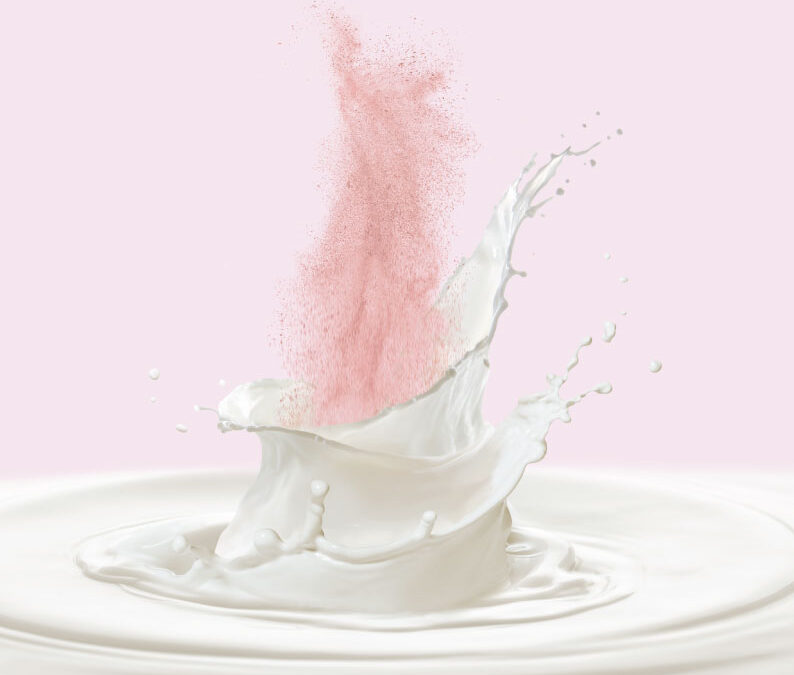Properties of lactoferrin
Lactoferrin is a glycoprotein naturally present in breast milk that is known for its ability to regulate the immune system. Scientific studies also report bacteriostatic (prevents multiplication of pathogens), bactericidal and antiviral effects.
A variety of studies conducted between 2007 and 2016 have already demonstrated the benefits of lactoferrin in infant nutrition, highlighting the role that this glycoprotein may play in intestinal development and resistance to infections. Its immunomodulatory abilities can be partly explained by its positive effects on intestinal flora.[1] A 2007 study concluded that lactoferrin helps protect infants from minor respiratory infections during the first months of life.
This natural protein is present in human secretions such as tears and saliva, and in greater concentrations in breast milk. Its strong affinity for iron increases absorption. It can be used to limit infections as an antimicrobial agent, stimulate the immune system, improve intestinal health, or prevent iron deficiency.
Lactoferrin as a treatment for Covid-19
Used as an antimicrobial and anti-inflammatory agent, as well as for its immunoregulatory effects, lactoferrin has serious potential for research on Covid-19 prevention.
The direct and indirect antiviral effects of lactoferrin have been demonstrated in vitro [2]. It limits microbial growth due in part to its ability to bind to iron, but lactoferrin also interacts with microbial, viral, and cellular surfaces to inhibit microbial adhesion and viral penetration of host cells.
The antiviral effects of lactoferrin are generally attributed to its clearly demonstrated ability to regulate the immune system. But it has also been shown [3] that it can directly interfere with the life cycle of many viruses. Lactoferrin acts on the binding process of adenoviruses, for example, inhibiting replication. It also interferes with infection by binding to structures in the viral envelope. We also know that lactoferrin can interfere with other viral particles in vitro, such as the feline herpes virus.
Promising trials in Covid-19 prevention and treatment with lactoferrin
Due to its multiple functions, scientists consider lactoferrin to be an ideal candidate in the fight against the SARS-CoV-2 coronavirus, the cause of Covid-19.[4]
Two promising in vitro studies, one conducted in 2011 on SARS-CoV and the other conducted in 2020 on SARS-CoV-2, have shown that lactoferrin can inhibit viral infection in the early stages and is effective against SARS-CoV-2 in the post-infection phase.[5]
The 2020 study[6] was conducted by teams at university hospitals in Rome in order to evaluate the role of oral and intranasal administration of lactoferrin in 32 Covid-19 patients with mild to moderate symptoms, as well as an asymptomatic form of the disease. The goal was to document the efficiency of the protein in improving symptoms and eliminating the virus. The study also used a control group of 32 healthy volunteers. A dose of 1 gram of liposomal apo-lactoferrin in 10 capsules per day was administered orally for 30 days, in addition to the same form administered nasally 3 times per day. All patients demonstrated improvement in every symptom except fatigue, which continued in about a third of the group. Other very promising data has emerged from these studies, such as a drop in D-dimer concentration, which is crucial in prognosis for the disease, as well as regulation of Interleukin 6 (IL-6), one of the three pro-inflammatory cytokines.
Properties of lactoferrin used in manufacturing protective masks
The Virustatic Shield is an antiviral textile developed after 10 years of research in the United Kingdom. It is used to fight airborne propagation of RNA viruses such as influenza, SARS, and Covid-19. It is not really a PPE mask, but more of a face covering like a neck warmer. Highly breathable, it can block, capture, and deactivate respiratory viruses on contact. The Virustatic Shield snood uses a hydrophilic material tested for its ability to block and retain the virus coated with Viruferrin™ – a patented substance that contains natural proteins including lactoferrin – which adds another layer of protection by binding to the virus and capturing it on the surface of the material, preventing inhalation.
The natural protein lactoferrin has been used for its virus-fighting and preventive properties for several years. Its antiviral properties are particularly promising for research on Covid-19 prevention and treatment. When associated with other agents, lactoferrin can mitigate symptoms of the illness and prevent transmission.
——————
[1] Cuibai Fan. Effect of lactoferrin, probiotics and SM3 (milk extract enriched in sphingolipides) on immune function in mice. Life Sciences [q-bio]. AgroParisTech, 2008. English. ffNNT: 2008AGPT0054ff. ffpastel-00005539f
[2] Berlutti F, Pantanella F, Natalizi T, Frioni A, Paesano R, Polimeni A, et al. Antiviral properties of lactoferrin–a natural immunity molecule. Molecules. 2011;16(8):6992-7018. Epub 2011/08/19. doi: 10.3390/molecules16086992. PubMed PMID: 21847071; PubMed Central PMCID: PMCPMC6264778.
[3] Redwan EM, Uversky VN, El-Fakharany EM, Al-Mehdar H. Potential lactoferrin activity against pathogenic viruses. C R Biol. 2014;337(10):581-95. Epub 2014/10/06. doi: 10.1016/j.crvi.2014.08.003. PubMed PMID: 25282173.
[4] Campione, E., Cosio, T., Rosa, L., Lanna, C., Di Girolamo, S., Gaziano, R., Valenti, P., and Bianchi, L. (2020). Lactoferrin as Protective Natural Barrier of Respiratory and Intestinal Mucosa against Coronavirus Infection and Inflammation. Int J Mol Sci 21.
[5] Mirabelli, C., Wotring, J.W., Zhang, C.J., McCarty, S.M., Fursmidt, R., Frum, T., Kadambi, N.S., Amin, A.T., O’Meara, T.R., Pretto, C.D., et al. (2020). Morphological Cell Profiling of SARS-CoV-2 Infection Identifies Drug Repurposing Candidates for COVID-19. BioRxiv.
[6] Ibid.

